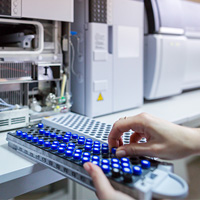Types of mass spectrometry

Mass spectrometry is an analytical technique used to calculate the mass to charge ratio (m/z) of molecules within a sample. This can often be useful for determining the precise molecular weight of a compound, and prove the identity of isotopes.
Mass spectrometry has both qualitative and quantitative applications. It can be used to identify unknown compounds, determine isotopic composition, and also to determine the structure of a compound based on its fragmentation. This wide range of uses makes mass spectrometry a great tool in analytical laboratories that study physical, biological, and chemical properties of a large variety of compounds.
When choosing which method of mass spectrometry to use, there are a few factors to consider. First, it is important to determine the level of sample preparation and throughput potential. At times it may be more advantageous to run multiple samples on a single matrix.
For example, MALDI-MS (Matrix-assisted laser desorption mass spectrometry) method would be ideal for multiple samples as a single matrix can handle up to 96 sample analysis in an hour. Other testing systems may be only able to handle a single sample analysis per hour.
Conversely, running a MALDI-MS test requires considerable preparation when handling a sample. This is a more tedious task than sample preparation for other forms of mass spectrometry. Ultimately, every methodology will come with advantages and disadvantages.
In this article we will breakdown the benefits of the most common mass spectrometry systems.
Tandem mass spectrometry (MS/MS)
Tandem mass spectrometry, known as MS/MS or MS2 is a method of mass spectrometry where two or more mass analyzers are coupled together. This process includes an additional reaction step which increases their ability to analyze the sample.
MS/MS offers additional information about specific ions. In this method, target ions are put through a quadrupole filter during the first round of MS and are then fragmented by a number of dissociation methods. There are a few options for dissociation:
- Collision-induced dissociation (CID)
- High energy collision dissociation (HCD)
- Ion fragmentation include electron-transfer dissociation (ETD)
- Electron-capture dissociation (ECD).
Once fragmented, the particles are then separated based on their individual m/z ratios in the second round of MS. Tandem MS is often used to sequence proteins because the fragments can be used to match predicted peptide or nucleic acid sequences found in databases. The fragments can then be further organized in silico into full-length sequence predictions.
This kind of sequencing prediction can be incredibly useful in biomedical applications. MS/MS has been used in newborn screening to determine the presence of treatable genetic and metabolic diseases.
Gas chromatography (GC) and liquid chromatography (LC)
Gas chromatography (GC) and liquid chromatography (LC) are excellent methods of separation, used for analyzing complex gas or liquid samples via mass spectrometry. Each has their own distinct benefits.
Liquid chromatography-mass spectrometry (LC-MS) is used for the analysis of thermally unstable and nonvolatile molecules, such as sensitive biological fluids. This would often include polar compounds such as organic acids and nucleotides.
On the other hand, gas chromatography-mass spectrometry (GC-MS) is applied to the analysis of volatile compounds such as petrochemicals, like flavonoids, lipids, or essential oils.
There is however, some overlap between the two, as compounds like alkaloids, amino acids, and steroids can often be tested in either GC-MS or LC-MS
LC-MS and GC-MS use different methods for ionization upon introduction of the compound into the mass spectrometer. LC-MS will often require electrospray ionization (ESI) resulting in production of aerosolized ions. Whereas, GC-MS samples may be ionized directly or indirectly via ESI.
As far as accuracy goes, LC and GC both offer a lot of promise. These forms of mass spectrometry offer a level of accuracy in compound detection that may be overlooked by other biochemical analysis techniques. With MS technology you will be able to detect small degradation products, process impurities, and various proteoforms of your desired product.
High performance liquid chromatography (HPLC)
High performance liquid chromatography, or HPLC is another technique used to separate, identify, and quantity components in a given sample. HPLC relies on a system of pumps to pass a pressurized liquid solvent combined with the sample mixture through a column filled with a solid, absorbent material. As the sample interacts with the adsorbent layer, each unique compound will have a different flow rate leading to the separation of the components within the sample.
HPLC is the most common separation method to study biological samples. It has been utilized in manufacturing, legal and forensics, as well as for medical and research purposes. Samples must typically be liquid, nonvolatile, and be able to fit through the columns with relatively low flow rates (e.g. 200 nL/min).
Since HPLC relies on a pump system rather than gravity to operate, it is one of the more efficient systems as the process typically takes 10 to 30 minutes. HPLC systems are automated and produce high resolution results quickly, saving time and requiring minimal training.
Precision and Versatility
As an analytical technique, mass spectrometry provides distinct advantages with high sensitivity and accuracy in results. This is because the analyzer, as a mass-charge filter, significantly reduces background interference that might be present in other systems.
Mass spectrometry provides an analytical tool to specify characteristics via fragmentation patterns to identify both known and unknown compounds. It can uncover details about molecular weight, and abundance of elements to deepen your understanding of your sample and its unique attributes.
Whether you plan to test liquids, gas, or solids - stable or even volatile molecules - there is a mass spectrometry system that can work for you. For more information on mass spectrometry check out all our resources under mass spectrometry and chromatography. Avantor is here to support your laboratory or manufacturing team with all your analytical chemistry needs.